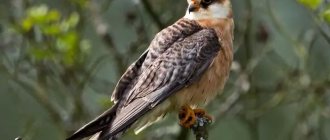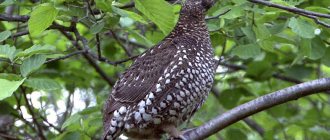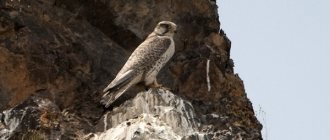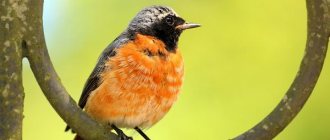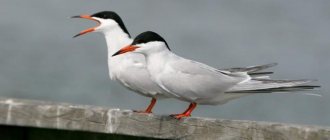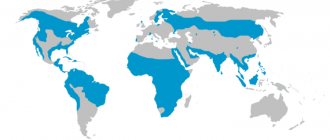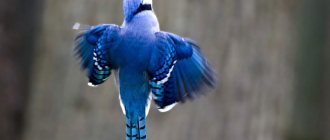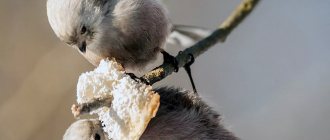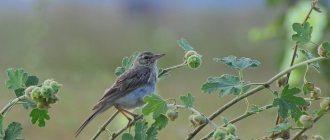Banana-eater bird , Guinea turaco or Green turaco is a bright representative of the African ecosystem. They are common in the lowland and floodplain forests of West Africa. They are also called the African Cuckoo or the Tropical Cuckoo. Cuckoos are indeed the closest relatives of turacos. Turaco spends most of its life in trees, descending to the ground only to drink water. Guinea turacos are not big fans of flying; they would rather climb branches than use their wings.
Turaco is characterized by a relatively short, slightly swollen beak, a peculiar semicircular crest on the head of an adult bird, and relatively short rounded wings. Length 40-43 cm, weight 225-290 g. Green color dominates in color - it is present on the head, neck, chest and upper back. The back of the back, rump and tail are blackish with a lilac or violet metallic sheen. The lower part of the belly and undertail are also blackish, but without shine. The color of the crest is completely green, without a white edge. A white spot is developed in front of the eye, bordered with black below; There is a red leathery ring around the eye.
The dominant color of the plumage is bright green, which allows the birds to be less noticeable among the foliage and gives the name to the whole family of these birds. The color of this bird is similar to a peacock feather - the same iridescent shade of emerald. The fact is that the metallic green color in the turaco’s plumage does not arise due to the refraction of light in the microstructures of feathers, as in other birds, but due to the presence of a special pigment that is no longer found in any other animal - turacoverdin, which contains iron. The poorly studied pigment turacoverdin belongs to the group of porphyrins, which are quite soluble in water, so the water in puddles after a turaco bathes in them acquires the appropriate color, and the wet feathers of these birds discolor or become dull brown if the bird gets very wet in tropical rain. After some time, she again becomes a bright beauty.
They live in evergreen gallery (floodplain) and tropical rainforests, often near cultivated landscapes. Preference is given to mature secondary plantings. In the Cameroon Highlands they are found up to an altitude of 1385 meters above sea level. Banana eaters easily survive in captivity and are distinguished by their lively disposition and unpretentiousness in food. The diet consists mainly of the fruits of tropical plants - dates, wild figs, musanga, ficus, macaranga, rauwolfia, cissus, nightshade, and also eats flowers and buds. The name “banana eaters” is not entirely correct, since they practically do not eat bananas.
It is believed that the turaco's breeding season usually coincides with the rainy season. However, despite similar climatic conditions, reports on the timing of breeding vary greatly: for example, in Cameroon, egg laying was observed in May-June and August, and in neighboring Gabon from December to February and from June to September. Monogamous, nests in isolated pairs in an area protected from other birds. The nest, which is a shallow and rough structure made of twigs (similar to a pigeon nest, but more voluminous), is placed in a fork of branches in the dense crown of a tree or bush at a height of 1.5-5.3 m above the ground. The clutch usually contains 2 eggs, almost spherical in shape, cream-colored. Both members of the pair incubate for 21-23 days. Chicks are nesting type, when born they are covered with a thick layer of down. Parents take turns feeding their offspring, regurgitating the food they bring from beak to beak. At the age of 26-28 days, the chicks leave the nest for the first time, still remaining on the branches nearby. The ability to fly appears at about 38 days of age, but they are fed by their parents for another 9-10 weeks before they become completely independent.
The first scientific description of the Guinea turaco appeared in 1758 in Carl Linnaeus's System of Nature. Giving it the name persa, which means “Persian” in Latin, the author referred to the similarity of the shapes of the bird’s crest and the tiara, an ancient Persian headdress. There are three subspecies of the Guinea turaco: - Tauraco persa buffoni - Tauraco persa persa - Tauraco persa zenkeri. The variability between them is manifested in additional details of the head pattern. Subspecies are distinguished mainly by the white postorbital stripe - its width and length.
The banana-eater can be found in such African countries as Mali, Guinea-Bissau, Guinea, Sierra Leone, Liberia, Cote d'Ivoire, Ghana, Togo, Benin, Nigeria, Cameroon, Equatorial Guinea, Gabon, Congo, South Central Africa Republic, Democratic Republic of the Congo (formerly Zaire) and Angola.
Features and habitat of the turaco bird
Turacos are long-tailed birds belonging to the banana family. Their average size is 40-70 cm. These birds have a crest of feathers on their heads. It stands up as a mood indicator when the bird feels excited. There are 22 species of turaco in nature. Their habitat is the savannah and forests of Africa.
These feathered forest dwellers have bright purple, blue, green and red plumage. As you can see in the photo, turaco comes in a variety of colors. We will introduce you to the different types of turaco. The purple turaco is one of the largest banana-eating species. Its length reaches 0.5 m, and its wings and tail are 22 cm.
The crown of this beautiful bird is adorned with delicate and delicate red plumage. Young animals do not have such a crest; it appears only with age. The remaining feathers are dark purple and the underparts are dark green. The wings are blood red and dark purple at the tip.
Pictured is a purple turaco bird
There is no feathering around the brown eyes. Legs are black. The purple turaco is found in parts of Lower Guinea and Upper Guinea. Livingston's turaco is a medium-sized bird. The elite of African society decorate their headdresses with feathers of this type of turaco.
Their color is influenced by pigments (turacin and turaverdine). When in contact with turaverdine, the water turns red, and after turaverdine it turns green. This wonderful bird looks especially gorgeous after rain. He now shines like an emerald. Livingston's turaco is found in Tanzania, Zimbabwe, South Africa, and partly in Mozambique.
In the photo there is a bird Turaco Livingston
The Red-crested Turaco, like the Livingston's Turaco, has red and green plumage. A distinctive feature of this species is its red comb. Its length is 5 cm. The crest stands up when the bird experiences a feeling of anxiety, danger and excitement. These birds cover the territory from Angola to the Congo.
Pictured is a red-crested turaco
Representatives of the Guinean Turaco belong to different races. Northern breeds are distinguished by rounded green tufts of the same color. The rest of the Guinea turaco has a pointed, two-colored crest.
The upper part of the bundle is white or blue, and the lower part is green. These birds have a rare pigment - turaverdine. Contains copper. Therefore, their plumage has a metallic green sheen. The adult size is 42 cm. The birds live from Senegal to Zaire and Tanzania.
Pictured is a Guinean turaco
The Hartlauba Turaco or Blue-crested Turaco is a medium-sized bird. Body length 40-45cm, weight 200-300g. The colors include red and green. Red - mainly on the flight feathers. Some of the pigments present in the plumage of synchochloids are washed off with water. For their habitat, they choose forested highlands at an altitude of 1500-3200 m, urban gardens of East Africa.
Pictured is turaco hartlaub
Description
The length of the body together with the tail is on average 45 cm. Weight ranges from 260 to 380 g. The plumage is predominantly green in color, in places with a blue tint. The head, neck and chest are light green, less often dark green.
The tail is blue, the wings are bluish-green above and reddish below. The red feathers on the wings are only visible during flight. The head is decorated with a crest of feathers up to 6.5-7.5 cm long. The tips of the feathers on the crest are painted white and resemble pearls.
The eyes are surrounded by bare red skin. The beak is pink-red. Two white lines diverge from it to the eyes. Currently, three subspecies of Livingston's turaco have been identified.
Life expectancy reaches 14-15 years.
Turacos are long-tailed birds, reaching a length of 35 to 45 cm. They have a straight crest of feathers on their heads. The color of the plumage is often metallic green and blue. The male and female within their species have no differences in color and size. Their flight feathers are dark red.
Livingston's turaco lives in tropical Africa, inhabiting rain, mountain and light deciduous forests, palm and acacia savannas. These birds come to the ground only to drink water or take a dust bath. They feed on fruits and berries, and to a lesser extent on leaves, buds, and flowers. Previously, these birds were called banana eaters, but they do not eat bananas. Monogamous. They live in families in permanent territories ranging from 4 hectares for small species up to 2 square meters. km for large ones.
Nests (platforms of thin twigs) are made in trees. During the mating season, birds demonstrate themselves by raising their crest of feathers and spreading their flight feathers widely. Both parent birds incubate the clutch for up to 3 weeks and then take part in feeding the brood. Turaco feathers are valued as an element of festive and ritual clothing among the nobility and warriors of many African tribes.
This rich world can surprise you with many colors and different surprises.
Here are just a few rare birds that boast unusual abilities or colors.
Character and lifestyle of the turaco bird
All turaco birds lead a sedentary lifestyle in tall trees. These are rather reserved birds. Flocks consist of 12-15 individuals, but they do not fly all at once, but take turns, like a scout. They silently fly from tree to tree. Having found a bush with berries, these timid birds do not stay long, but simply visit it often.
The blue-thorned turaco is trying to get back to the big tree as soon as possible, where it feels safe. When they are safe, their screams can be heard everywhere. Having all gathered together, these “beautiful birds” flap their wings and chase each other screaming.
Pictured is a blue spinal turaco
Turaco birds live in a wide variety of landscapes. Their habitats can be mountains, plains, savannas and tropical forests. The living area of turaco families ranges from 4 hectares to 2 km2, it all depends on the size of the birds. Very rarely, these birds come ashore, only in case of emergency.
They can only be seen on the ground during dust baths or watering. They spend the rest of their time in tree branches. These birds fly well and crawl through trees. Turaco, like parrots, easily survives in captivity. They are very unpretentious in food and have a lively disposition.
Growing generation
Grown-up turacos deftly jump through the trees like squirrels. This is the natural habitat of the banana-eater. They rarely leave their roosting branches, preferring to spend their time moving and energetically under the protection of thick leaves. The younger generation of banana eaters stops only to have a snack. And even then it takes a few seconds. They grab a fruit on one tree and immediately jump to another. The human eye will not be able to follow their rapid movement.
A description of the banana-eater bird would be incomplete without talking about the screams that are often heard in tropical forests. The voice of growing turacos is very loud, loud, sharp and shrill. It cannot be called musical at all. Unfortunately, these birds do not have vocal abilities.
Turaco food
Turacos belong to the banana-eating family, although these birds do not eat bananas. They feed on young shoots and leaves of tropical plants, berries and exotic fruits. An interesting fact is that different types of turaco eat some poisonous fruits that neither animals nor other birds eat.
They collect berries from trees and bushes, filling their harvest to capacity with these dishes. In exceptional cases, turaco can feed on insects, seeds and even small reptiles. To feed on large fruits, the bird uses a sharp, serrated beak. It is thanks to its sharp beak that it tears rafts from the stems and cuts their shells to separate them into small pieces.
Nutrition
Do banana eaters really love bananas? The answer is negative. Birds feed on berries, shoots, tree buds and insects. Fruits, of course, are included in the diet, but they are not a favorite food. If there is an alternative, the banana-eater will never eat a banana.
Interestingly, some species of banana eaters are even capable of eating poisonous fruits. No other birds or animals living nearby will do this. But the turaco is not afraid of anything. Birds are able to withstand hunger for quite a long time. This is explained by the fact that in one sitting the banana eater stuffs its crop to capacity with berries from the nearest bush. Eating small reptiles or insects is an exception to the rule.
Reproduction and lifespan of turaco
The turaco breeding season is April-July. At this time, the birds try to separate into pairs. The male calls during mating season. They nest in pairs, away from other members of the flock. The nest is built from many twigs and twigs. These shallow structures are found on tree branches. For safety reasons, these birds nest at a height of 1.5 - 5.3 m.
Pictured are turaco chickens
The clutch consists of 2 white eggs. Several of them take turns incubating for 21-23 days. Chicks are born naked. After some time, their bodies become covered with fluff. This outfit lasts 50 days. The process of maturation of offspring in turacos takes a lot of time.
And during this time, the parents feed their chicks. They regurgitate food brought directly into the baby's beak. At the age of 6 weeks, the chicks can leave the nest, but do not yet know how to fly. They climb trees near the nest. A well-developed claw on the second finger of the wing helps them in this.
It will take several weeks for the chicks to learn to fly from branch to branch. But responsible parents still feed their offspring for 9-10 weeks. These birds, despite the long maturation period, are considered long-lived. The life expectancy of a turaco is 14-15 years.
Varieties
- Violet. Prefers forest edges somewhere in Nigeria or Gambia. Most often they live in pairs, but sometimes they form a flock.
- Guinean. Belongs to the category of very caring parents. In addition to making a deep and well-guarded nest, the couple also feeds their children until they are 10 weeks old.
- Red-crested. Lives in the forests of Congo and Zaire. Hidden, sits motionless on the highest branches of trees. In case of danger, he runs away very quickly. During the mating season, the male likes to raise his high crest, spread his wings and scream loudly.
- Big blue. Perhaps the only large representative of the genus. Height - 76 cm, weight - 1200 g. It has a very long tail, a straight crest, and a bright blue color on the chest. Lives in Congo, Kenya, Guinea, Tanzania, Nigeria. It flies very poorly. Prefers to run and jump from branch to branch. Birds prefer to stay in small groups.
- Helmet-bearing. Also called white-cheeked. A bunch of feathers, wide and tilted back, form a helmet. The abdomen is a nondescript gray color, and the body is bright green. Red at the end. Length - up to 40 centimeters. The female can be distinguished from the male by size, the girl is smaller.
Description of the banana-eater bird
Especially the turaco is a big eater of blue bananas, it is a medium sized bird with a body length of about 70 centimeters. They fly very poorly, but thanks to their strong legs they jump well.
More than twenty species of such birds live in Africa. All individuals have a unique exotic color that leaves no one indifferent.
The color of the feathers is so varied and saturated with all the colors of the rainbow, which makes the birds look like fairy-tale characters. The light is especially bright in sunlight, so the bird becomes even more unusual, its feathers sparkle like precious stones.
In addition, the turaco has an unusually beautiful tail, which, when untied, is no worse than that of a peacock. This is not just a tail, it is a large, bright and colorful fan, from which it is impossible to take your eyes off. A banana eater has a tuft sticking out of his head. The wings are short and rounded.
Turacos are incredibly beautiful birds. Oddly enough, in appearance they do not differ much depending on gender. The habitat of these birds is usually steppes, forests and savannas, but wherever Turaco lives, he definitely needs trees. This is a favorite place for turacos. Banana eaters do not know how to build a nest; their nest is always undecorated and sloppy. It is somewhat reminiscent of a dove: flat, chaotic. But with such a view, the shortcoming can be forgiven.
The female lays two eggs at a time. The chicks are born completely naked, and only after some time their skin is gradually covered with down, with which they live for about 50 days. Chicks develop rather slowly:
- eggs hatch in 3-4 weeks;
- From the moment the chick hatches until it leaves the nest, about 40 days pass;
Chicks covered with a duvet cannot fly. But thanks to the structure of their wing, on which the claw is located, they climb tree branches beautifully and with great dexterity. And only after a week they leave the nest and try to learn to fly short distances.
Adult turacos are very active, jumping from branch to branch with such agility that it is sometimes unnoticeable. In their natural environment, banana lovers feel comfortable and incredibly energetic. Without movement, they can only be seen while eating. And then, rarely. As a rule, a banana eater, having taken a berry, immediately jumps to another branch or tree. Turaco will be announced with a loud tropical cry. This is not a nightingale's song, this is a sharp, sharp cry. Banana eaters are poor singers and you will not hear long songs or musical chants from them.
The Turaco diet is based on plant foods: tree sprouts, fruits and berries. Despite their name, banana eaters don't like bananas. It is not known why they were named that way, but certainly not because of their gastronomic preferences.
There are a total of 14 species of banana eaters. Next we will briefly talk about some of them.
Reproduction
The mating season runs from August to February depending on the habitat. Reproduction of the species in natural conditions has been poorly studied. It is known that the female most often lays 2 eggs, reminiscent of pigeons.
Nests are located high above the ground in tree hollows.
Incubation lasts about 28 days. Both spouses are involved in feeding the chicks. The chicks are blackish in color, which changes to green as they grow older. They become winged at about 1.5 months of age, but continue to be dependent on their parents for another 2-3 months.
Barnacle turaco
Turaco shell is a decoration of the banana family. It's a small bird, but its colors are fantastic. There are white feathers around the eyes and on the cheeks of the bird, while its main plumage is bright and colorful. The bird's tail is also decorated in white. The comb on the turaco's head is aquamarine. It was the comb that gave this bird its second name - scallop. Externally, the female is practically no different from the male.
The turaco shellfish lives in East Africa.
The nesting period begins in April and ends in July. During the mating season, the male calls the female with a loud cry, and her cry is heard throughout the forest.
A shapeless and unstable nest of turacos is built on trees from branches. The nest is flat, with a small depression in which the eggs and then the chicks are located.
During the mating season, banana eaters live in pairs, after which quite large family groups are formed from the pairs. Birds are almost constantly on the move, stopping only to rest or eat. Turacos are very shy, therefore, having found a berry or the fruit of a fruit tree, the bird, having collected food, will immediately hide at the top of the tree. Turacos can play with each other, reach out and flap their wings.
The banana eater flies with short wing beats, then unfolds its wings and slowly descends, and then beats its wings again.
If there are nutritional deficiencies, banana lovers can supplement their diet with insects and seeds.
Family
It can be very difficult to distinguish between male and female banana-eater birds. Sexual dimorphism is completely absent. Mother and father work together to build flat, rough, “pigeon” nests. The future nursery resembles a flat platform hidden in the thicket of branches. Typically, the female lays two white eggs. The chicks hatch completely naked. They don't have any bright colors yet. They resemble something, only after a couple of days they are covered with dark fluff, unlike others. The dark outfit will be on the chicks for quite a long time - almost 2 months.
The development of the embryo and then the chick occurs very slowly. Incubation lasts about 20 days. Only after 6 weeks do the chicks begin to try to leave the nest. Moreover, the small banana-eater bird cannot fly. There are small serrations on the wings, with the help of which turacos move through the trees. Chicks do not fly, but climb.
Blue-crested turaco
This is a medium sized banana dish. The body length is from 40 to 45 centimeters, the weight of the bird does not exceed three hundred grams. The main plumage is green. The crest on the top of the head is blue. This species is monotypic.
Like other banana eaters, blue-crested chicks are born completely hairless and become covered with black down only after a month and a half.
This is a sedentary bird that spends most of its life in a tree. If the bird is in danger, it hides in the thickets of trees, while actively using the claw on its wing.
The blue crested banana eater prefers:
- berries;
- fruits;
- verbena fruits.
Let's shout
If food has been discovered by the flock, then the timid bird will not linger long on the bush with the berry. The banana eater will simply visit the found “dining room” very often. Birds feel safer in tall trees. And it is from there that loud screams are heard throughout the area. In the photo, a banana-eater bird makes its migration. She strives to quickly get to the safe zone, because there, in the heights, among the dense crown, you can chase each other to your heart's content, flapping your wings and screaming.
Red-crested turaco
This is the only representative of the genus that has green and red colors in its plumage. The bird's body does not exceed 40 centimeters in length. The distinctive feature of this turaco is the crest on the top of its head, which is a true shade of red feathers. The bird's fingers are movable in all directions. The female is no different from the male.
The main feathers are green-blue, the wings are cherry-colored. Thanks to this color, the bird cleverly camouflages itself on the top of a tree and becomes completely invisible.
Both parents incubate the eggs. Together they also take care of the chickens' nutrition.
The red-crested banana plant lives exclusively in trees. The bird feeds mainly on insects and berries.
Turacos live in families of thirty or more individuals, but during the mating season they split into pairs and take care of their mate.
Beautiful birds of the Earth
Long-tailed velvet weaver
These South African birds are so named due to their incredibly long tail, which can be almost 2 times the body length, reaching 60 cm (such long tails are characteristic of males).
Brilliant painted painter
In his breeding plumage, the male, as a rule, has a bright blue color (sometimes black). Outside the breeding season, the color of males does not differ from the color of females, being gray-brown. It is worth noting that these birds are polygamous and, moreover, different partners will help the female in raising the chicks.
Crowned flyeater
There are 4 species of crowned flyeaters. At first glance, the bird is ordinary, but if you tease it, you will notice how it unfurls its gorgeous crest. Males have fiery red crest feathers with blue tips, while females have orange or yellow feathers.
Scaly bird of paradise
This bird lives in humid forests in New Guinea. It is distinguished by unusual long feathers extending from its head. When it was first brought to Europe, people thought the feathers were fake.
Quezal
Many consider this bird the most beautiful in the world. This is the national bird of Guatemala, the currency of this country is named after it, and the image of this bird can be seen on the coat of arms of Guatemala. Quezal is not able to live in captivity. Some believe that the bird can die from a broken heart. Being freedom-loving, it was not for nothing that the quezal was chosen as a symbol of the struggle for independence.
Lilac-breasted Roller
First of all, this bird is distinguished by its bright color: the chest is purple, the belly is blue, the head and back of the head are green, and a white stripe can be found near its eyes. In addition, the bird's face is reddish in color, and its wings have a brown tint with a bright blue color at the bottom.
It is also worth noting that during the mating season, you can see how males perform incredible acrobatic tricks in the air so that the female notices them.
Inca tern
This bird loves the Pacific coast of South America (Peru, Chile). It is distinguished primarily by its "whiskers", which are actually white curled tufts of feathers, each of which can reach a length of 5 cm. In addition, the bird stands out from the rest with its bright red beak and red legs.
Curly-haired arasari
This species got its name because of the unusual shape of the head feathers - they are curled, like ribbons on gift wrapping. The name “arasari” is translated from Latin as “feather-tongue” - this indicates the distinctive features of the structure of the tongue of these particular toucans.
The curly-haired aracari lives in Brazil, Guiana, Bolivia, Peru and Ecuador.
Blue-capped Tanager
This bird lives in humid mountain forests, as well as in forest edges. Her home can be located at an altitude of up to 1,000 meters above sea level. The blue-capped tanager can be found in eastern South America.
Blue-headed magnificent bird of paradise
The habitat of this bird is Indonesia, and more specifically, the islands of Waigeo and Batanta, located northwest of the island of New Guinea.
This bird of paradise can be identified by its curly tail feathers and unique coloring. The crown on the male's head is actually a piece of skin, not feathers.
Guiana cock of the rock
The almost perfect semicircular light orange comb of the males of this species is actually a formation of two rows of feathers. It stretches across the bird's entire head and even partially covers its beak.
This bird lives in tropical and subtropical forests of Guyana and southern Venezuela. The Guiana cock of the rock loves areas rich in water bodies - it can be found near the Rio Negro River basin.
Lilac-capped painted painter
This bird stands out not only for the lilac color of the crown of its head, but also for its song. The fact is that, unlike other fairies, this one usually sings in a duet, quite loudly, using low purity.
Livingston's turaco
This bird can be found in tropical Africa. She lives in rain, mountain, and light forests. Turaco rarely comes down to the ground, and only to drink water and take a dust bath. It is worth noting that these birds were previously called banana-eaters, which is quite strange, because... They don't eat bananas.
Shiny real cotinga
This bird lives in the upper part of the tropical rainforests of Brazil, Venezuela, Colombia and Bolivia. Her home is usually located at an altitude of up to 600 m above sea level.
Males have beautiful colors. It is worth noting that the dark purple feathers that adorn the neck of the brilliant coting sparkle beautifully in the sun
Bare-throated bell-ringer
It is immediately worth noting that the metallic ringing voice of this bird can be compared to a bell, and this sound is the loudest in the world of birds. The bird can be found in the mountain rainforests of Brazil, as well as in Paraguay and northern Argentina.
Indian Hornbill
This bird stands out for its yellow beak with a large helmet. The hornbill can be found in the tropical forests of southern Asia. She is an omnivore, loving fruits, fish and small mammals.
Indian tribesmen believe that hanging a hornbill skull will help them gain wealth.
Bluebrow Momot
This bird lives in Central America. Its distinctive feature is its long tail. At the end of the tail, two even longer tail feathers can also be seen. These feathers fall off over time due to frequent cleaning of the feathers with the beak.
Red-billed Alcyone
To make a nest, this bird digs holes, the length of which can reach 50 cm. It is worth noting that the red-billed alcyone feeds on large insects, rodents, snails, fish, frogs, and also likes to hunt songbirds.
Little Sultana
Habitat: southeastern United States, central and northern parts of South America; it sometimes flies to western and southern Europe.
This bird deftly climbs the stems of tall plants. She can easily swim in water like a duck and walk on floating plants like a chicken thanks to her long fingers.
Kea
This bird is from the parrot family. She lives in New Zealand, and can be found in human habitats - near ski lodges, tourist hotels and campsites. It is worth noting that this is the only parrot in the world that lives and breeds at an altitude above 1,500 meters above sea level.
Livingston's turaco (lat. Tauraco livingstonii) is an elegant medium-sized bird from the family Musophagidae of the order Musophagiformes. In many African countries, only representatives of high society still have the right to decorate their headdresses with feathers.
The bright colors of the feathers are given by the pigments turacin and turaverdin, which are simultaneously found only in this species. The first pigment is capable of coloring water red, and the second green. For this reason, the bird looks especially impressive after rain. When wet, it resembles a huge sparkling emerald.
Turaco purple
Home Animals Birds Arachnids Purple turaco
The purple-eyed turaco has blue plumage with a purple tint. The forehead and crown are carmine. A white stripe runs along the lower eyelid. The beak is relatively thick at the base, rounded at the apex and extends onto the forehead with a rounded shield-like plate. The unfeathered nostrils are located in the center of the beak. Despite the original appearance and no less exotic name, purple-eyed turacos are close relatives of the most common cuckoo.
Lifestyle
The turaco's habitat consists of tall forest plantations and riverine forests of West Africa. When feeding, it runs quite quickly along horizontal branches or jumps from branch to branch. Turaco feeds on fruits, berries, young shoots and buds of various trees and shrubs.
They appear heavy and slow in flight, and their wings are often used for protection against predators. Sensing that something is wrong, the purple-eyed turaco freezes and then flaps its wings vigorously.
Reproduction
At a safe height of more than six meters, the pair builds a flat nest from branches and pieces of bark. Both birds with equal zeal monitor the inviolability of their personal territory and, after the chicks appear, they also approach their upbringing responsibly. The clutch consists of 2 eggs. Unlike cuckoos, which feed their young to other birds, turacos raise their young on their own. Their babies have an interesting feature. Still unable to fly, they leave the nest despite being in a tree. On the second wing finger they have a well-developed claw, which helps them climb trees. The babies crawl out of the nest, clinging to branches, and only after a week they begin to turn over from branch to branch.
Family Bananaeaters / MusophagidaeBanana eaters are quite large birds. These are the largest representatives of the order of cuckoos: the largest species of banana-eaters are larger than crows. The color of the plumage of these birds is bright: violet, purple-red, green, blue, etc. This is one of the features of banana eaters. The fact is that most birds have bright metallic colors that shimmer in their plumage - the result of an optical effect that occurs when light is reflected from the fine structure of the feathers. In banana eaters, the remarkable purple-red color of the wings is due to a special pigment containing a significant amount of copper - turacin (not found anywhere else in nature), and the green color is due to the still poorly studied pigment turacoverdin. There is no sexual dimorphism. The wing of banana eaters is rounded, relatively short (shorter than the tail), and many species have a well-developed crest on the head. The beak is yellow, short, with a strongly convex upper beak ridge. The edges of the beak are usually serrated. Banana eaters are common in sub-Saharan Africa (they are not found in Madagascar), where they lead a sedentary, partially nomadic lifestyle. Some species live in open landscapes - in the steppe and savannas, others inhabit forests, but in both cases they are closely associated with trees. Banana eaters are monogamous. During the breeding season, they build flat nests in trees, carelessly constructed from small twigs, reminiscent of pigeons. There are 2 white eggs in a clutch. The chicks hatch naked, but, unlike the chicks of real cuckoos, they are soon covered with a downy plumage. This outfit remains on the chicks for a long time - more than 50 days. In general, both embryonic and postembryonic development of chicks is slow: incubation lasts 3 weeks, much more time (6 weeks) passes from the hatching of the chicks to the moment they leave the nest. The chicks leaving the nests do not yet know how to fly. On the second finger of the wing, banana-eater chicks have a well-developed claw, with the help of which they easily and freely climb trees. Only after another week do the chicks begin to flutter from branch to branch. By type of food, banana eaters are herbivorous birds, eating fruits, berries, young shoots and buds of various trees and shrubs. Contrary to their name, they do not eat bananas. The banana-eater family includes about 20 species, grouped into 5 genera.
White-cheeked Baneater / Tauraco leucotis
The white-cheeked bananaeater itself is not large in size. The plumage of this bird is very bright and beautiful. The head, neck, back and chest are bright green, the belly is gray, the rump is gray-blue, the tail is blue, rather long. The flight feathers are dark red (crimson) in color, the wing coverts are gray-blue. Around the eye and on the cheek the plumage is white, for which this banana-eater received the name “white-cheeked”. There is a sea-green comb on the head, which is why the bird is often called the crested banana-eater or simply the crested one. There is no sexual dimorphism. The white-cheeked banana-eater is widespread in East Africa, where it leads a sedentary lifestyle. In different parts of the range, white-cheeked banana-eaters nest at different times, but in general the breeding season of these birds lasts from April to July.
White-cheeked banana beetle |
Birds stay in pairs at this time. The male emits a kind of calling cry—a ringing “hyu-hyu-hyu...” that echoes through the forest like a silver bell. The rather loose nest is constructed from a large number of dry branches and is a flat, large, artlessly built platform with a small and shallow tray in the middle. Nests are placed in trees. The clutch consists of 2 white eggs. The chicks hatch naked, but are soon covered with short black down, which they retain until they leave the nest. Chicks develop, as already noted, slowly. These birds spend their entire lives in the dense thickets of the tropical forest. They are found in both mountain and lowland forests, but always in damp areas, overgrown with tall, large trees and dense bushes; They can often be seen in riverine thickets. White-cheeked banana-eaters live either in pairs (during the mating season) or in family groups, which sometimes unite in fairly large flocks. These bright birds are constantly on the move: flying one after another from tree to tree, they linger only on large trees, where the entire flock stops to rest. These birds spend most of their time in the branches of trees, along which they run very deftly and quickly, and when jumping from branch to branch, they use their long tail and wings. These birds descend to the ground only for a very short time and only in places where they can easily hide in dense bushes. These are hidden birds. Flying from tree to tree, they follow one after another, and not all at once, and at the same time they always remain silent. Having found some bush with ripe berries, the birds visit it very often, but do not stay there long, trying to quickly hide in the top of some large tree; where they seem to feel safe. However, having gathered together on a large tree, the birds become extremely noisy: they flap their beautiful wings and, screaming, chase each other among the branches. The flight of the white-cheeked banana-eater is very peculiar: several quick flaps of its wings lift the bird up into the air, then it spreads its wings and tail for a moment and quickly falls down, and then flaps its wings again, collecting its tail. White-cheeked banana-eaters feed on various fruits and berries, which they pick from trees and bushes and with which they stuff their crops beyond measure. Occasionally, insects are found in the food of these birds, and even more rarely, plant seeds and small reptiles, which the birds grab on the ground.
Purple banana beetle / Musophaga rossae
| The purple beetle, which lives in the forests of Central Africa, is perhaps the most beautiful of the turacos. It is violet-blue in color, with a large crimson-red crest on its head of elongated feathers on the back of the forehead and crown, and with purple-red wings. The bare skin around the eyes, the front of the forehead and beak are bright yellow, the front of the beak is red. This banana-eater is of medium size: its wing length is 22-24 cm. Being a clumsy, poorly flying bird, the purple banana-eater runs very quickly and deftly jumps (like a squirrel) in the branches of trees. | Purple banana beetle |
Crested turaco / Corythaeola cristata
| The crested turaco differs from other species of banana-eaters by the presence of large blue, slightly raised crest feathers on the head and its variegated coloring, as well as its large size. This is the largest bird of the entire order of cuckoos: the body length of the turaco is about 1 m. The dorsal side of the body of this bird is greenish-blue, the head is especially intensely colored. The tail is yellow with a blue base and a wide black transverse stripe near the apex. The neck is blue with a white throat, the rest of the ventral side of the body is brownish-red. The beak is yellow with a red tip. The eyes are red, the legs are lead-gray. Turacos are widespread in the tropical forests of equatorial Africa. | Turaco crested |
Ethiopian turaco / Tauraco ruspolii
| The Ethiopian turaco is distinguished by clearly visible white streaks on the long feathers around the head and an iridescent emerald green crest. It is slightly smaller than the white-cheeked banana-eater: its wing length is 18-18.4 cm. Few zoologists have been lucky enough to see the Ethiopian turaco in its natural environment: it lives only in one inaccessible region of Africa. The place where the Ethiopian turaco is found occupies only 25 km2. This is a juniper forest with a dense evergreen undergrowth, located in southern Ethiopia in a largely unexplored area. Turaco flight feathers are highly prized by many African tribes, who use them as decoration. Individual parts of the body of various species of banana-eaters are widely used for the preparation of supposedly healing potions. | Turaco Ethiopian |
Therefore, almost all species of banana-eaters are becoming rare due to excessive hunting, but the situation of the Ethiopian turaco, whose range is so limited, is especially tragic. This species is listed in the Red Book of the International Union for Conservation of Nature and is threatened with extinction.
Violet turaco
| Purple turaco | |
| Jacksonville Zoo, Florida | |
| Least Concern (IUCN 3.1) | |
| Scientific classification | |
| Kingdom: | Animalia |
| View: | Agreements |
| Class: | And weight |
| Order: | Musophagiformes |
| Family: | Musophagidae |
| Type: | big-eyed turaco |
| Views: | M splendor |
| Binomial name | |
| shine as a big-eyed Turk (Isert, 1788) | |
The purple turaco, also known as the purple plantain eater (rosaco violacea), is a large turaco, a group of African quasi-passerines.
Characteristics
it is an unmistakable bird, but shy and often unnoticed in the treetops. They are approximately 48 cm (19 in) long, including the long tail and 4 cm (1.6 in) banknotes. They have a wing length of 21 cm (8.3 in) and a weight of about 360 G. The plumage is bright purple except for the yellow forehead, chestnut crown and white fish stew; the beak is large and red. In flight, the purple turaco's primary crimson feathers contrast with the purple plumage. The red color of the wings is typical of Turacos.
Adult turacos
The adult banana-eater bird looks very beautiful. The plumage contains the brightest colors: red, yellow, blue, bright green, purple, pink and others. Moreover, the green color of feathers is given to birds by nature. Banana eaters' wings acquire an emerald hue over time. It is divided into trees containing a special pigment. If an adult banana beetle gets caught in heavy rain, its “outfit” becomes dull and inconspicuous.
The bird from the banana-eater family has a long tail and a crest on its head. The turaco's beak is very short, but quite strong and massive. They can live in damp tropical forests and plains, as well as in mountains and savannas. Completely unpretentious and picky. They may not come down from the tree to the ground for a long time. They hide there very skillfully, freeze, not making a sound. Although in reality turacos are very noisy, loud and fussy birds.
Habitat
it is native to West Africa and has a very large range from Senegal to Nigeria, with isolated populations in Chad and the Central African Republic. Found in tropical savannas, swamps, forests and forests.
> Diet
The diet consists of fruit and they are partial to figs, but they also eat leaves, buds, flowers, insects, snails and slugs.
> reproduction
This species exhibits cooperative breeding in captivity. The female lays two eggs in the fragile wood of the nest platform.
> Threats
The species is locally common but is vulnerable to capture for the pet trade in Guinea, Sierra Leone, Liberia and Ghana.
Distribution and behavior
Livingston's turaco is found in Tanzania, Burundi, Malawi, Zimbabwe, South Africa and eastern Mozambique. At the western edge of their range, the birds coexist with a related species, the long-foreheaded turaco (Tauraco schaowi), which prefers a drier climate.
The natural habitat is dense tropical rainforests located in both lowlands and highlands at altitudes up to 2500 m above sea level.
These birds fly very poorly, so they prefer to move along the treetops in search of food.
Their diet consists almost entirely of various fruits and tropical plants. If they are deficient, they eat flowers, young leaves and blossoming buds.
Turacos live in pairs or small groups. They have a tolerant attitude towards other bird species, but clearly do not like their relatives from neighboring groups. The feathered beauties fiercely defend the borders of their domains from them. In captivity, Livingston's turacos usually have a calm, friendly character and get along well with the rest of the household.
Recommendations
- BirdLife International (2012). "Turakovsky radiance." IUCN Red List of Threatened Species. Version 2013.2. International Union for Conservation of Nature. Retrieved November 26, 2013.
- shtastny Karel; Beychek, Vladimir; Vasak, Pavel (1998). "Turakoviti (Musophagidae)". Svět zvířat B. Ptáci (2) (in the Czech Republic). Prague: Albatros, Nakladatelství pro děti mládež, aspen 76. ISBN 80-00-00657-X.
- Leaning over, Nancy; Corbett, Francine (1993). "Auxiliary behavior and other nesting observations in the purple turaco." Magazine "Bird". 99 (3): 132-135. ISSN 0005-2256.
Birds of the Gambia Barlow, Vacher and Disley, ISBN 1-873403-32-1 Purple Plantain Eaters (Purple Goggle-eyed Turaco) https://www.torontozoo.com/explorethezoo/AnimalDetails.asp?pg=436
Amazing world
Turaco is a bird from 40 to 70 cm long with a long tail. They have a tuft of feathers on their heads that rise up when excited. There are only 22 species of turaco in the world. They are found only in Africa and live in forests and savannas. Many turacos have green, blue or red plumage.
Such birds include the helmeted turaco. On the other hand, Lemvogel has an inconspicuous color. Gray Lemvogel has gray plumage.
This bird makes little noise (in German Laerm - "noise"), but it makes a voice, especially when irritated, and its voice is reminiscent of the English words "go away" - "to leave". That is why in many places in Africa where this bird is found, it is called that. The largest of all species of this family is the giant turaco, up to 70 cm long and weighing up to 1 kg. The turaco's closest relative is the cuckoo.



